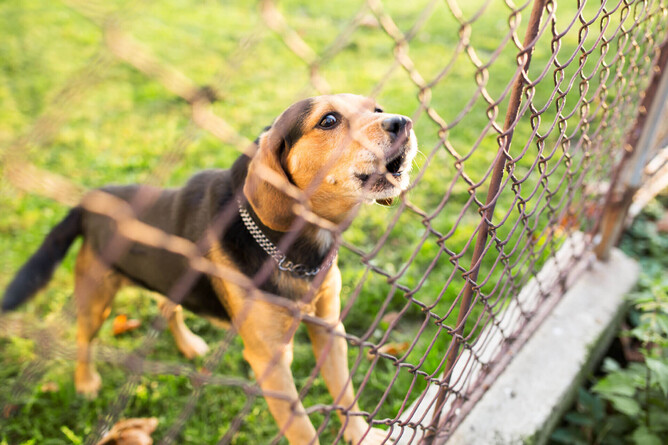Many dogs fence fights making dog owners wonder what this behavior is all about. It's actually quite a common sight for people who walk their dogs by fenced yards to see dogs who are highly aroused and barking. One moment they're barking at the trigger, the next they're at each other, growling and barking as if they were actually fighting.
Why do dogs fence fight? One moment dogs are barking at a trigger, the next they're at each other, growling and barking as if they were actually fighting and worse enemies. What gives? It almost looks like they are arguing over who saw the trigger first or who gets to bark to the trigger. Thankfully, there's a fence between them to prevent them from getting injured, but why do dogs fence fight in the first place?
Frustration from Barriers
When some dogs are put behind a fence, they become prone to fence running and fence fighting behaviors. Both fence running and fence fighting are manifestations of what is called "barrier frustration", also known as restraint frustration since, with the barrier, dogs are prevented from going where they want and doing what they want.
Why are dogs frustrated? This frustration stems from the repeated presentation of stimuli that the dog strongly desires to investigate and approach, but cannot because of the presence of a fence or some other type of restraint that prevents access to these stimuli.
This leads to frustration over time, and soon, the dog learns to associate the mere sight of these stimuli with a Pavlovian response of frustration.
Getting Riled Up
As dogs develop frustration, their levels of arousal sky rocket and up goes the adrenaline rush. This over-the-top state can easily tip into aggressive behavior.
One may assume that a dog must be aggressive to start with to see this happen, but even an excited state of mind can switch over to aggression, given the right circumstances.
Soon, the barrier frustration spills into re-directed aggression, where one dog appears to attack the other or both dogs end up attacking each other.
Fortunately, the fence acts as a protective barrier so it just turns out into a loud discussion, but some dogs are able to break the fence, jump over it or dig under to access the other dog.
Practice Makes Perfect
The more dogs get aroused and frustrated and vent their frustration by "fence fighting", the more this behavior puts roots and becomes established. These frequent rehearsals make the behavior habitual and more difficult to overcome.
Dogs who are kept always outdoors and are exposed to countless stimuli that evoke frustration, are more challenging to treat for this type of behavior because the behavior has a strong history of rehearsal, compared to a dog who is let out at various intervals during the day and occasionally engages in fence fighting with a neighbor dog.
A Mixed bag of emotions
Often, neighbors cringe at the thought of their fence fighting dogs meeting one day. Yet, surprisingly, in many cases, when the dogs get to meet face-to-face without a fence protecting them, they end up manifesting prosocial behaviors.
Not long ago, a video of dogs fence fighting made the rounds on social media sites. Interestingly, the dogs are fence fighting right by the edge of the fence. They could reach each other with no problems, but prefer to stay protected behind the fence and safely "discuss" from there. You can watch the video below.
However, it's important to point out that the outcome of letting two fence fighters meet can be unpredictable. Many times, the meeting yields an explosion of apparent anger, as the dogs release their frustration.
It is not unheard of for dogs to deliver particularly savage attacks after breaking free of a fence. Should dogs ever have to meet face-to-face, these meetings might have a better outcome if the dogs are introduced on neutral grounds, away from their territory and triggers, while always practicing the upmost caution.
Owners of dogs with a history of fence fighting should consult with a behavior professional before introducing the dogs or initiating any form of behavior modification.
Now you know...
As seen, dogs have their own reasons for fence-fighting. After all, it's quite normal for dogs to have to vent their emotions. Now that you know what triggers fence fighting in dogs, it's time to look at how to tackle the issue.
How to stop a dog from fence fighting
Because practice makes perfect, a good way to tackle fence fighting is to manage the dog's environment. There are several options to tackle this issue and of course, neighbors benefit too as they will no longer have to listen to the loud, disruptive discussions among neighboring dogs.
Here are some tips to reduce fence fighting behaviors in dogs:
Install a physical barrier. Without seeing triggers and each other, there are less chances for fence fighting to occur. The holes of chain link fences can be filled with nylon strips. However, some dogs can still get very aroused because they can still see through the spaces between on fence section and another.
If financial resources permit, you can install a privacy fence, or even better, a brick wall. This is by far the best solution for dogs who bark at triggers and have a tendency to fence fight.
Install a secondary fence. While this won't likely stop the barking at triggers, it will keep the neighboring dogs at a distance from each other so they're less likely to fence fight. The secondary fence should be installed several feet away from the property fence line.
Walk your dog on a leash when taking him in the backyard to avoid him from rehearsing the fence-fighting behavior. Stay as far as you can from the fence-line.
Keep your dog indoors and arrange outings. Find an agreement with your neighbor to let your dogs out at different times. Out of sight, out of mind!
Train a positive interrupter by starting indoors. Make a smacking sound and give your dog treats. Sound, treat, sound treat. Then train it in the yard when the other dog is not around. You might need to keep your dog leashed initially so he's prevented from rushing to the fence. Finally, when the neighbor dog starts barking, train your dog to respond reliably to the smacking sound you make and reward him with several high-value treats in a row. With time, the sound of the neighbor dog's barking becomes the cue to come to you for yummy treats. A win-win!
Always supervise your dog when he's out and call him inside as soon as you recognize signs that he's about to react to outside triggers. Do this before your dog starts reacting when he's still under threshold.
Avoid touching your dog when he's in an aroused state, this could lead to a re-directed bite.
If your dog is fence-fighting with another dog that shares the yard, see a professional to help you out.
Did you know?
When a dog experiences strong emotional responses, his limbic system is activated while his cerebral cortex is suppressed. This makes a dog unable to cognitively function when stressed, which means there's little space for learning.
Source Canine Neuropsychology, third edition, by James O’Heare, Ph.D., DogPsych, 2005.
ADRIENNE FARRICELLI CPDT-KA



